S.S. Johan de Witt of 1920 to 1948
Please Note: Firefox and some other Search Engines may not be suitable
Use Google Chrome for this Web Page to load perfectly!
Please Note: All ssMaritime and other related maritime
sites are 100% non-commercial and privately owned, thus ssmaritime is NOT
associated with any shipping company or any other organisation! Although the
author has worked and been involved in the passenger shipping industry for well
over 60 years, but due to his old age and poor health, he was forced to retire.
Yet, he has completed well over 1,435 Classic Liners, Passenger-Cargo Liners as
well as humble converted C3 converted Migrant Liners, which has transported
countless thousands folk to the new world, as well on vacations’. I trust
the features online will continue to provide Classic Liner and Ship enthusiasts
both the information they are seeking, but more so provide a great deal of
pleasure and relive many happy memories!
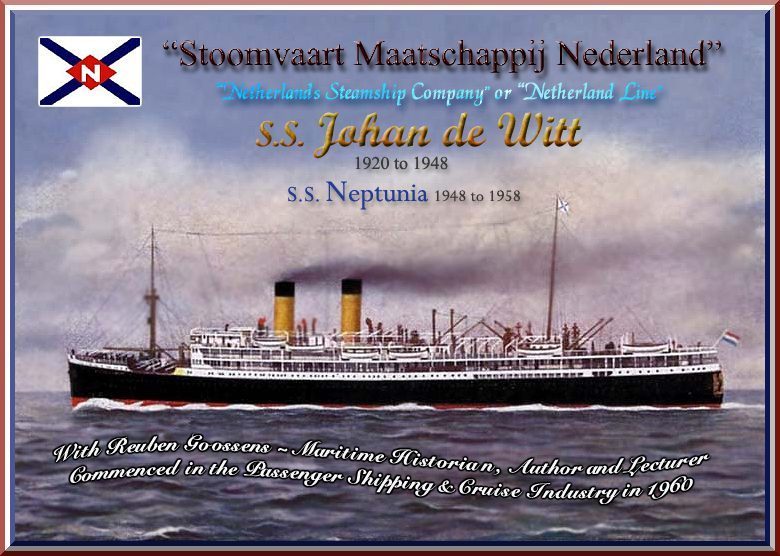
Please Note: Postcards, photographs & other images are either from the author’s private collection.
A special thanks to the ssmaritime supporters for sending their most
welcome photos & images
And a special ‘thank you’ to the “Australian War Memorial”
*********************
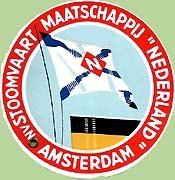
Introduction to the Company:
The company that is officially in Dutch,
“Stoomvaart Maatschappij Nederland” (SNM), was originally founded
in
Thus they commenced with vessels that could
carry passengers, mail, and freight most of it from
During the Great War, with the Netherland’s being a neutral country they took the
opportunity to establish a subsidiary Company being the “Java - New York
Line”, which originally operated via the Cape of Good Hope, but after
1917 they sailed via the Panama Canal. In due course new services were added to
include
Sadly World War II caused huge disruptions, but worse still heavy losses to the S.M.N. fleet, but in 1948 they set up new services between the Netherland’s to South Africa and South America, as well as the Persian Gulf and India.
Of course trade was severely affected due to
the independence of
In 1957 their two remaining passenger liners,
the
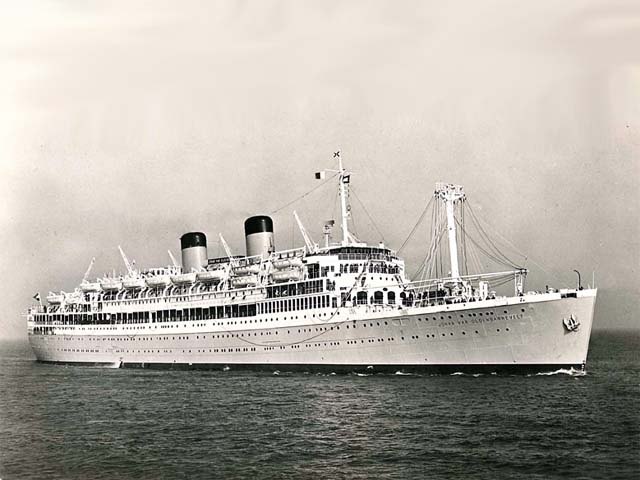
The “
She was sold to the Greek Line in 1963 to become the ill fated “Lakonia” (1963)
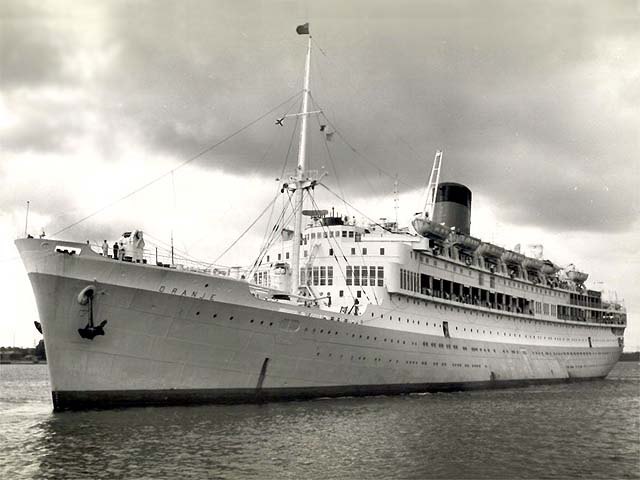
A little later the company merged with three
other companies in 1970 and the “
NSU in due course became part of “Nedlloyd”, and then S.M.N. became part of
“Koninklijke (Royal) Nedlloyd”, then in
1996 “
*********************
S.S. Johan de Witt
“Stoomvaart Maatschappij Nederland” (S.M.N.), also known as the “Netherlands Steamship Company” and the “Netherland Line”.
S.M.N. appointed the Naval architect of
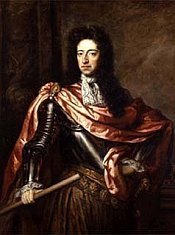
A painting of
From Construction to her Delivery:
On July 29, 1916, the “Netherlands
Steamship Company” placed an order for a new ship to be constructed, 1916
to the “
The famous
Her First Class featured the most luxurious interiors having been completely designed by “Lion Cachet”, and his design for both First and Second Class was simply exceptional! Obviously Third Class was more modest, but certainly very comfortable. Steerage passengers were berthed in larger cabins forward on a lower deck, but there was several cabins just for families with small children. She accommodated 188 First Class, 120 Second Class, 36 Third Class with 42 passengers in Steerage.
As a ship, she featured two tall masts and two
slender tall funnels, although her aft funnel was a dummy, and it was there to
provide the ship a better balance. Other details include her having six holds,
ten watertight bulkheads, and her foremast had four loading booms of 6 tons and
25 tons, as well as king posts and ‘Walin’
quadrant-davits. Also, the “
Due to it being the time of World War One, her
construction was extreamly slow as there were
frequent delays, as well as there were ongoing shortages of materials, and this
is why it took almost 3 years after her keel was laid down on July 29, 1916
that the “
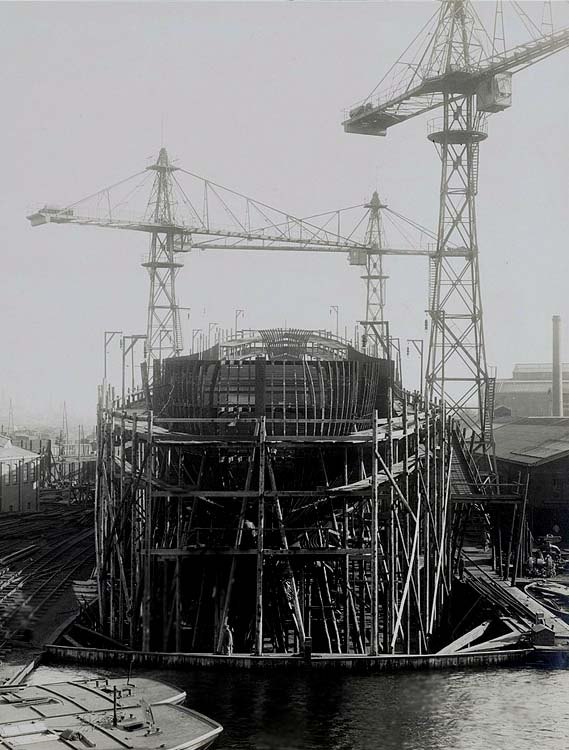
She is seen here with her hull partially built
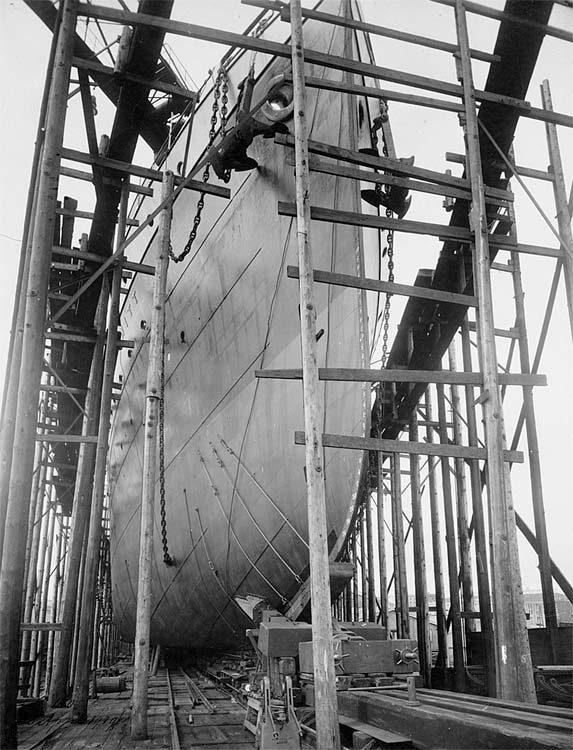
A fine bow shot prior to her completion
Although very late, she was officially launched without a great deal of fuss on May 2, 1919 and once she entered the River IJ, she was towed to the builders’ fit-out berth where she would be completed.
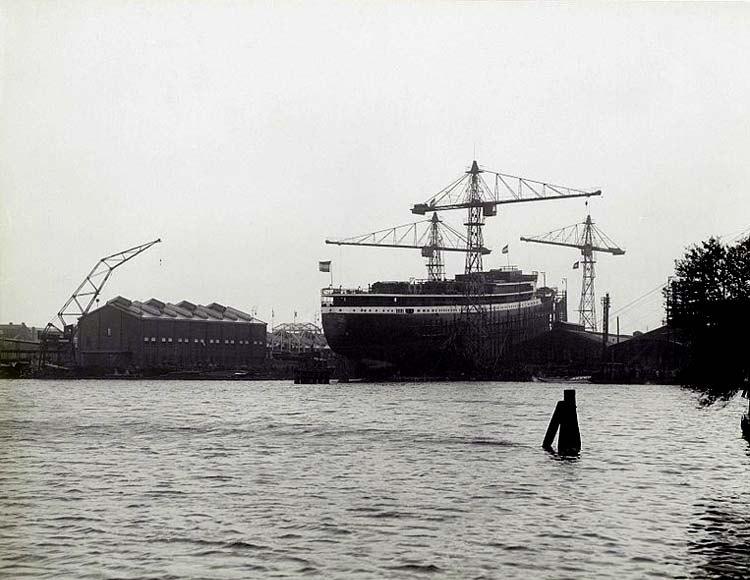
The “
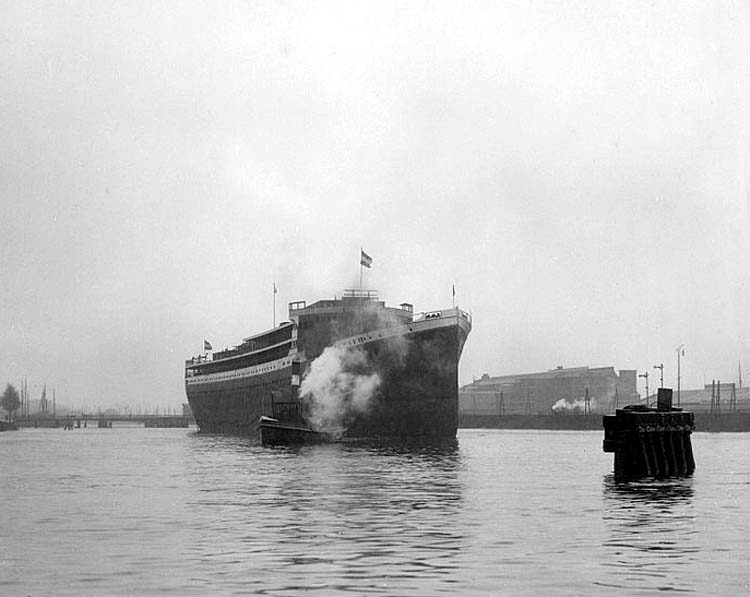
At the yard’s fit-out berth work on her
continued, with her superstructure and all her fittings and accommodations
installed. When the
*********************
Her Interiors and Exteriors:
I have a good number of photographs of the First Class venues, but sadly not too many of the Second and the Third Class venues, but what I have does provide an idea of what was available.
First Class:
I have an excellent Deck Plan Online CLICK HERE
When the plan opens it will be small, but just one click on the plan it will open to its full size
If walking passengers would use the magnificent Main Stairwell, and this grandiose stairwell is nothing short from stunning, and that is from the Entrance Hall down on Restaurant Deck (D) and it goes up to Promenade Deck(C) and then to B Deck being a accommodation deck (where the photo was taken). This stairwell is completely made from the finest reclaimed walnut timers with carvings of various famous Dutch individuals on separate panels as well as other spectacular features as can be seen on the photograph below.
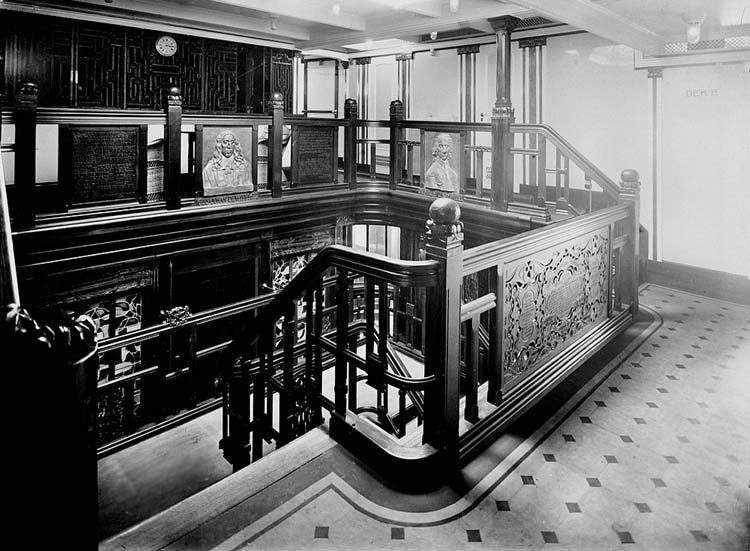
The Main Stairwell seen on B Deck, note the decorative feature
wall behind the stairs, this image is looking forward of the ship
Far forward on Promenade Deck (C) we find the
delightful Music Saloon, a venue that had the plushest and the finest carpets
that were available. The venue offered deep and comfortable lounge chairs with
small round walnut coffee tables, as well as other seating. The walls in this
room feature luxuriant timbers with various carvings and great art, and the
windows had delicately carved screens. The ceiling here featured beautiful and
delicate hand screened silk from the Dutch East Indies (
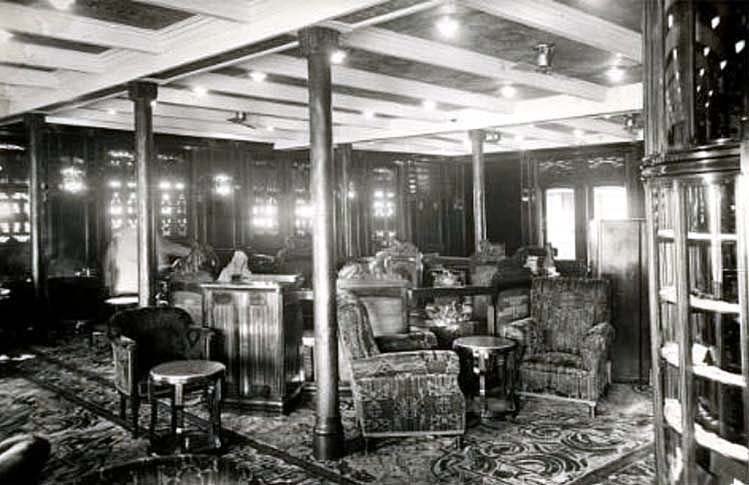
The Music Saloon
Directly aft of the Main stair well we come to a sublime venue, being the Smoking Room being separated into several sections, and even has different carpets in these, thus differentiating them. One section has the service Bar, and even the ceiling and the lighting is somewhat different. The room features walnut pillars carved at the top and again screened silk prints on the ceilings.
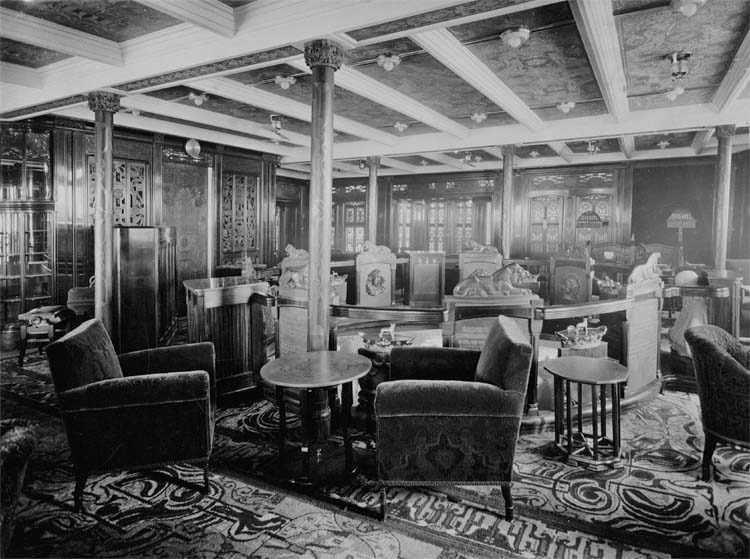
This section of the Smoking Room reveals its beauty and comfort and is the only section with these carpets
The balustrade looks down into Dining Room and the panels with the lions above contained marble
on this side but had carved walnut on the inside with heads of famous individuals
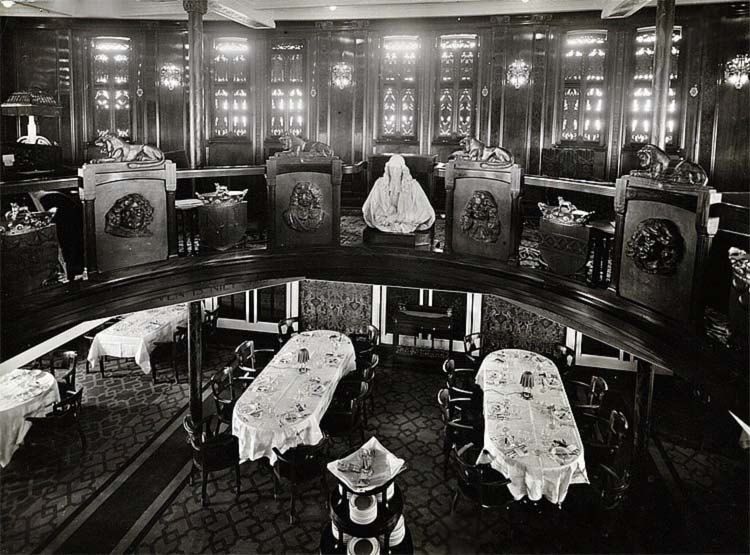
The marble carving
in the middle is obviously the Grand Pensionary “
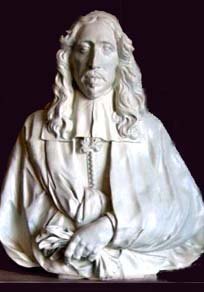
A close up of the
marble sculpture of
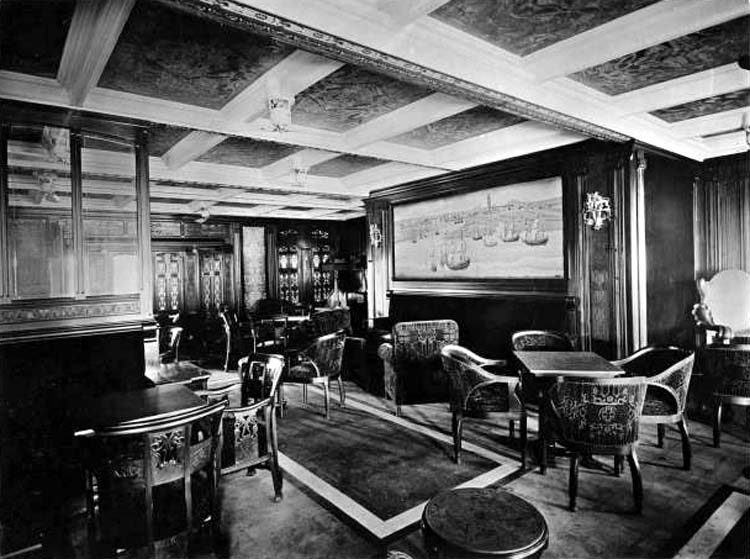
Above and below: Two views of the other section of the Smoking Room that had some unique timber chairs
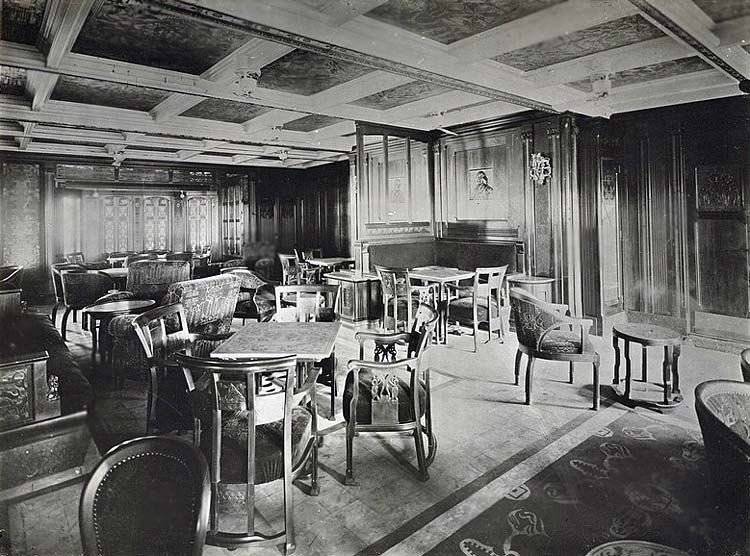
We now arrive in the Writing Room, which like all the venues on the ship is the ultimate of glamour as can be seen below. It has a balustrade that looks down to the Main Entrance hall below.
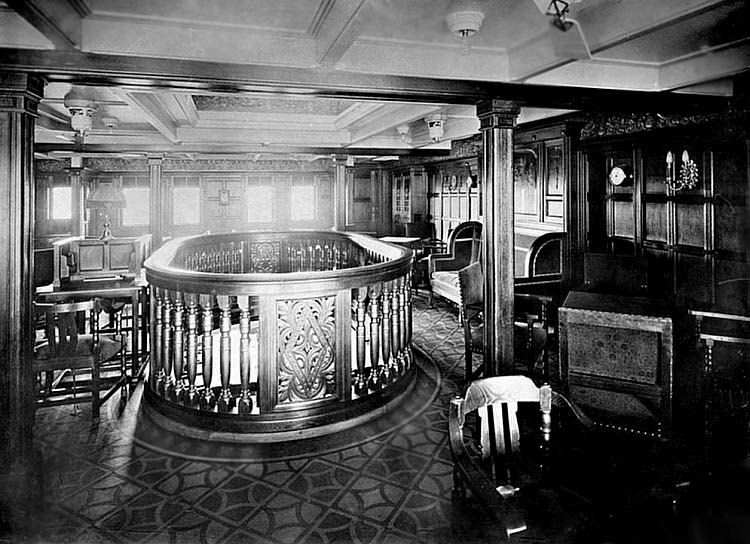
The Writing Room
Outside was the spacious Promenade Deck, which was the perfect place to relax outdoors and enjoy full service for stewards who would attend day and in the evening, as well as bring coffee, tea and bouillon in the morning and coffee or tea for afternoon tea, etc. In addition, music would also be performed during he day.
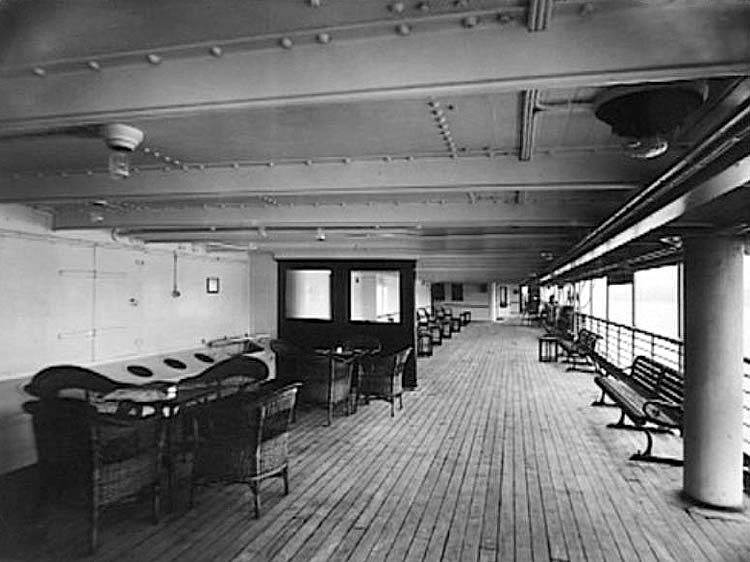
Above & below: The Promenade Deck
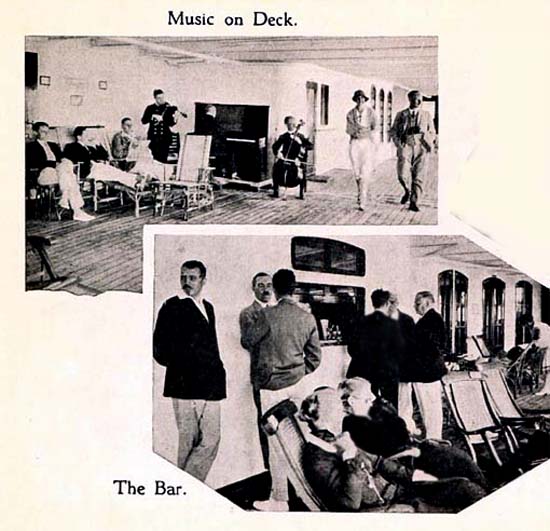
The Dining Room was spacious and offered tables from four to tables for twelve guests. The venue had exceptionally large portholes and room was richly decorated, and like the public rooms the ceilings also had screened silk prints inlaid between the columns.
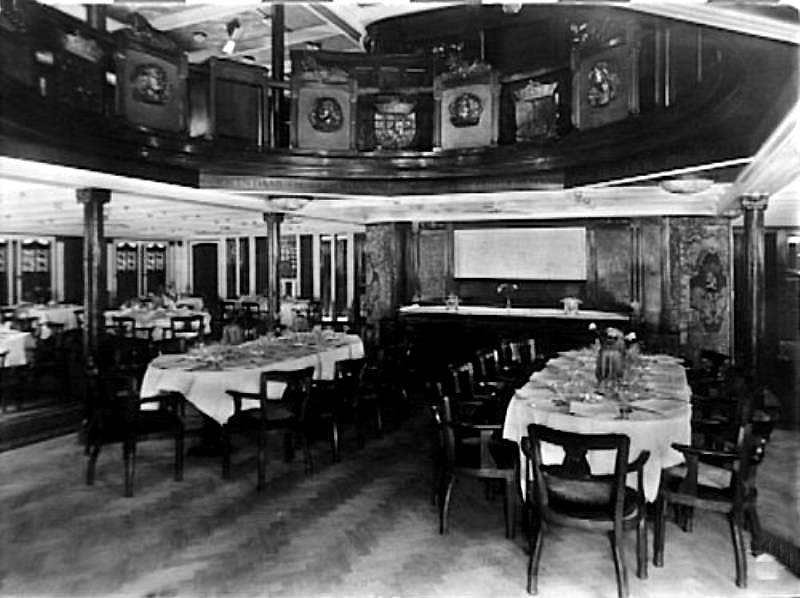
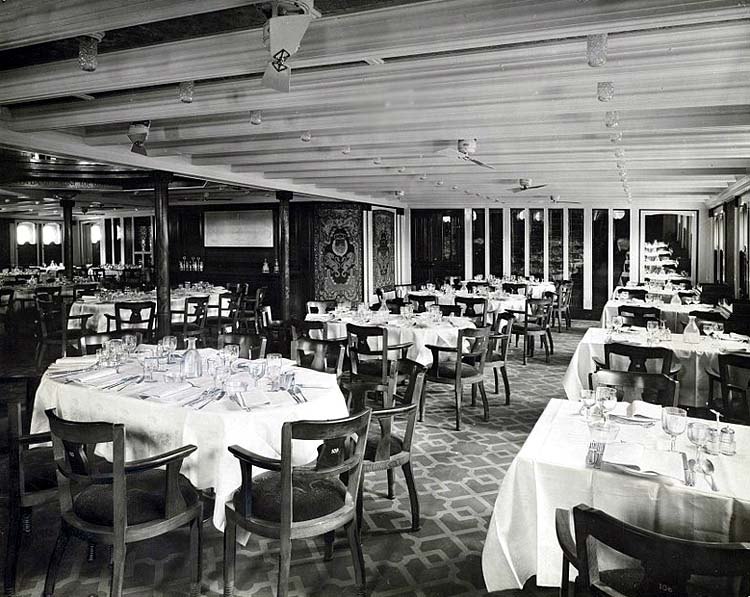
The Dining Room along the port side looking forward
The “
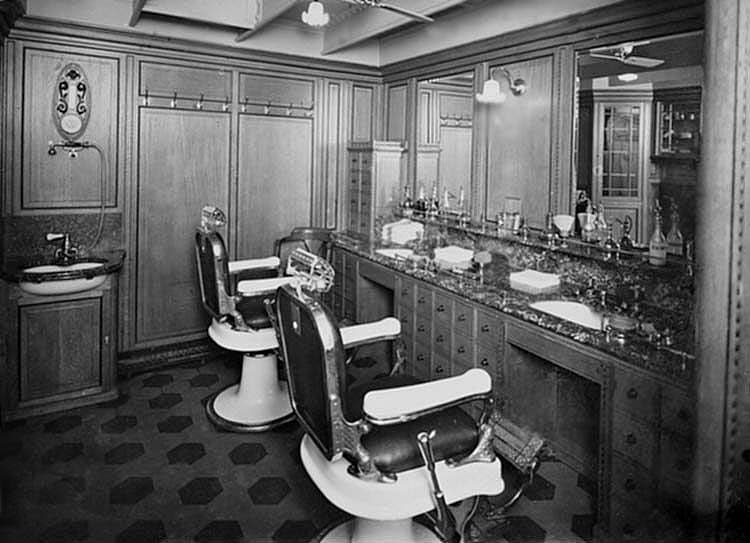
Of course every Liner has a Ladies Hair Dresser and a Men’s Barber as seen here
All First Class Deluxe Staterooms and cabins were outside rooms having a window or a porthole. Those cabins that seemed to be on the inside would have a section that reached the exterior and thus every cabin had light and could allow air in. This was a typical feature on Dutch liners.
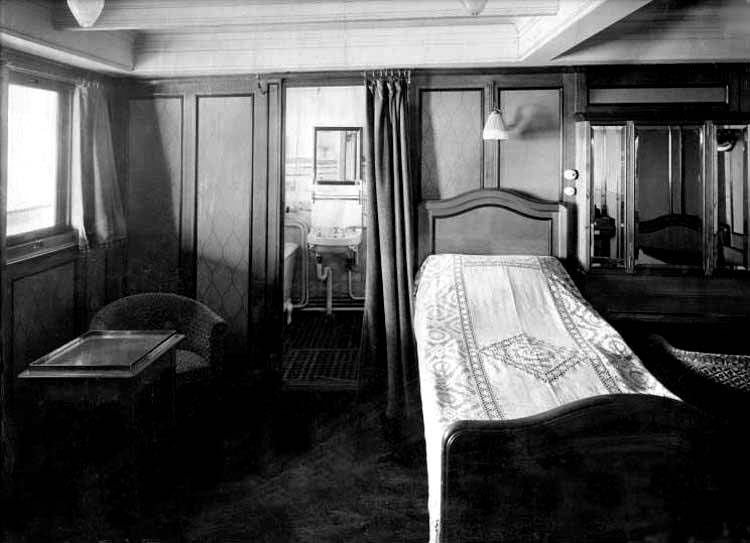
Bedroom of one of the deluxe Cabin with private facilities
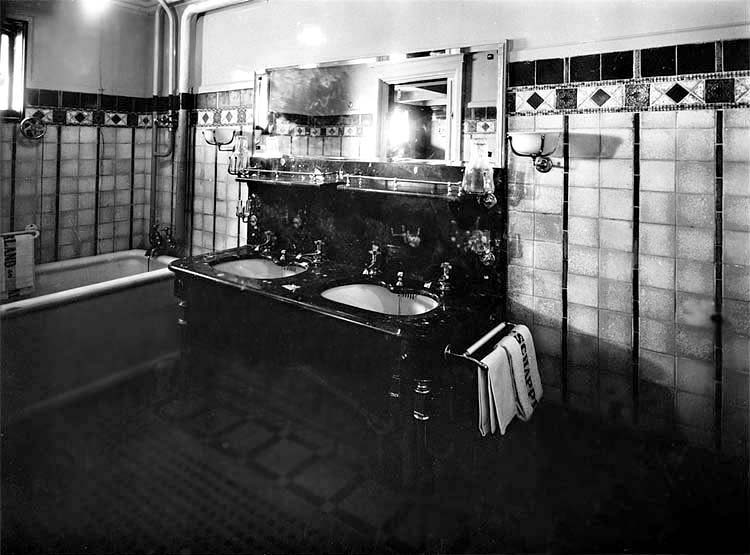
There is a spacious Bathroom for each of the Deluxe Cabin
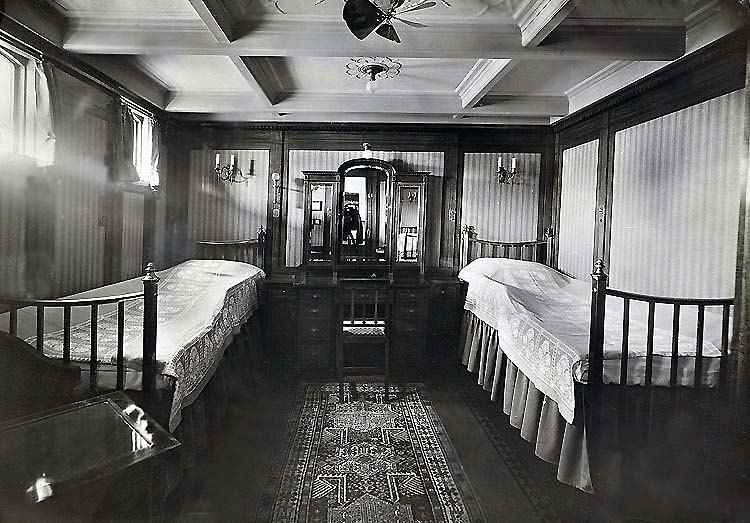
Bedroom of one of the deluxe Staterooms with private facilities
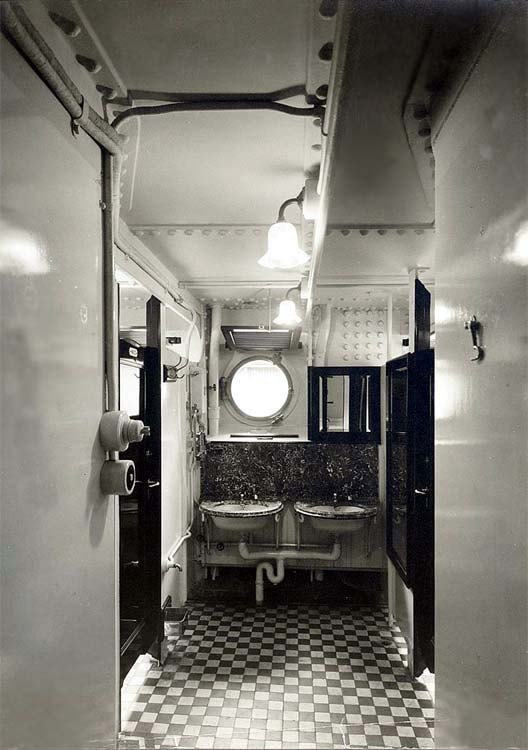
A private bathroom to a two bedded cabin
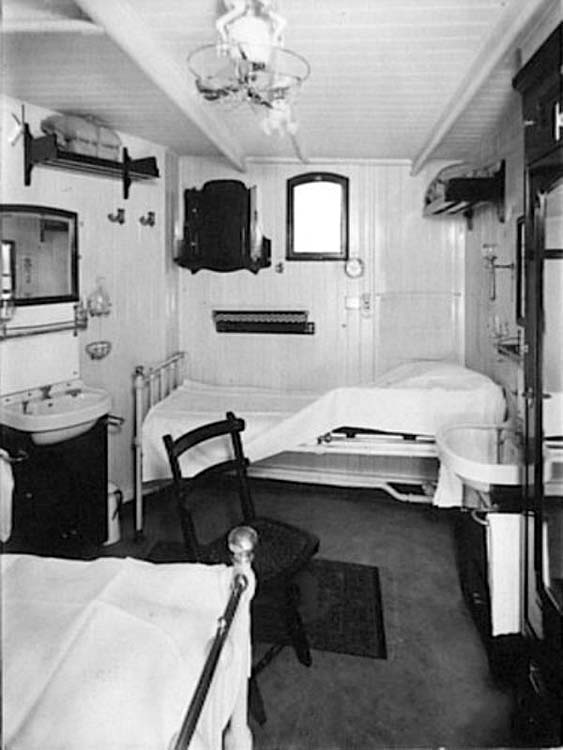
This is a standard two berth cabin
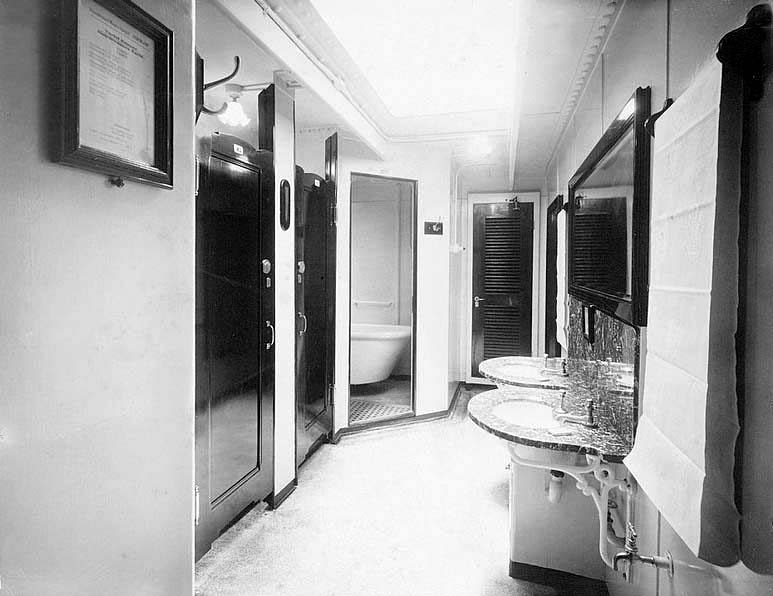
Here we see the spotless public bathrooms and WC
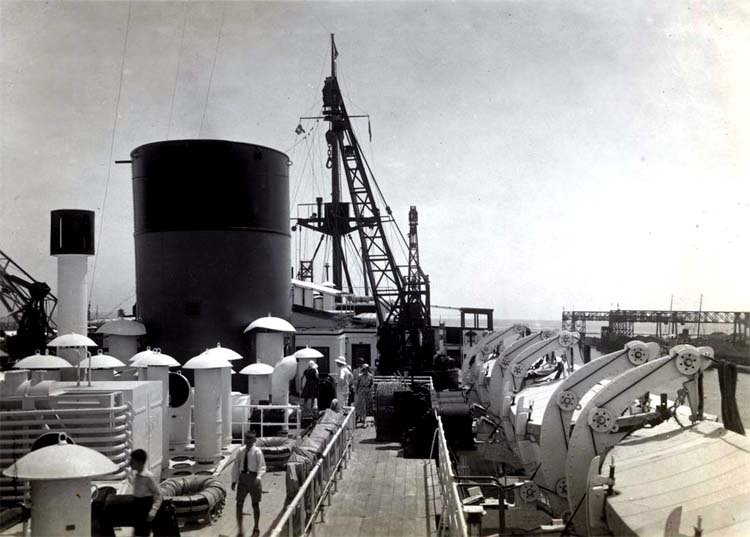
Besides Boat deck there were ample other decks to use topside, for sports or just viewing
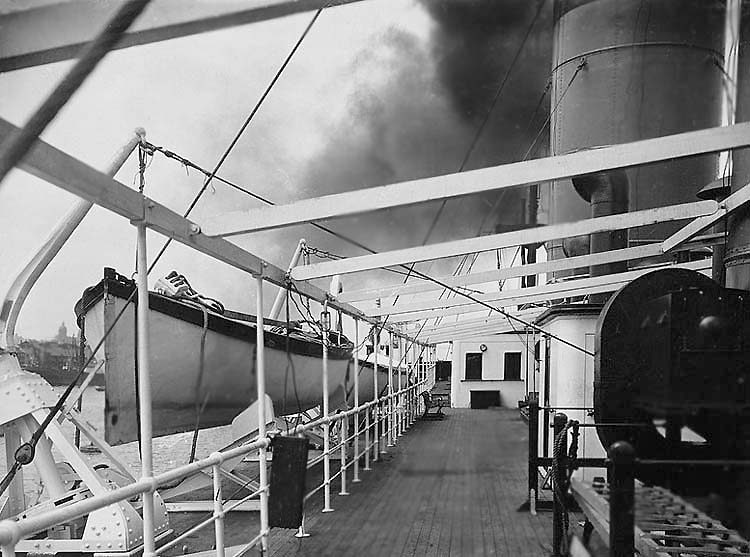
Boat Deck was a popular location for sports
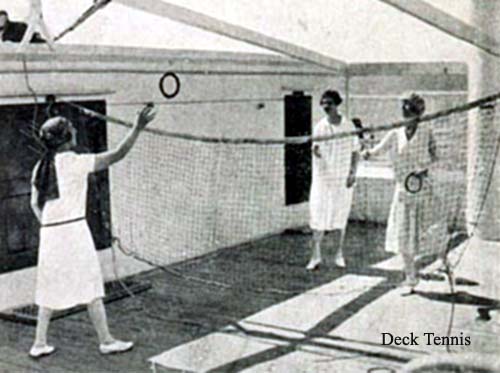
Above & below: Deck Tennis or Shuffle Board was played aft of Boat Deck
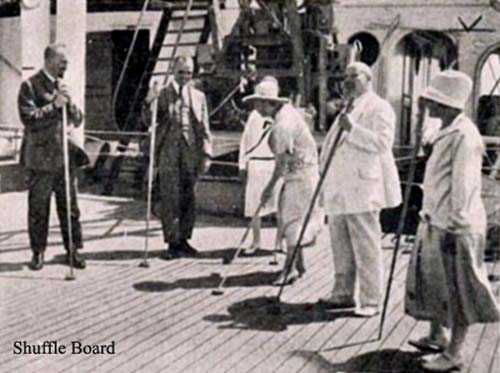
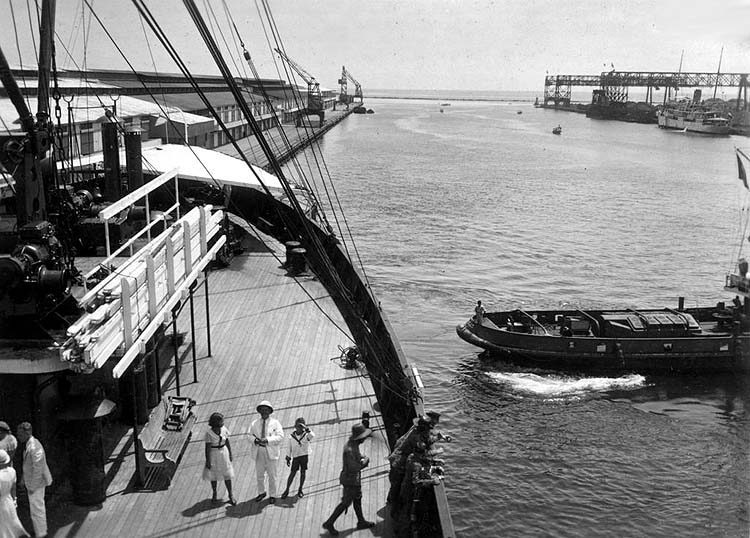
Only when in port,
First Class passengers could come up on the
*********************
Second Class:
Sadly I do not have a large selection of photographs of this Class. But I hope what I do have will provide a good indication of what it offered!
Just past halfway the Promenade Deck (C) the first Second Class venue is the Music Room although, like in First Class it is all fitted out in that beautiful dark timberwork finished with fine columns, and it was a delightfully spacious venue. In addition, the room was a light and bright during the day, thanks to the large uncovered windows, and it was certainly well furnished.
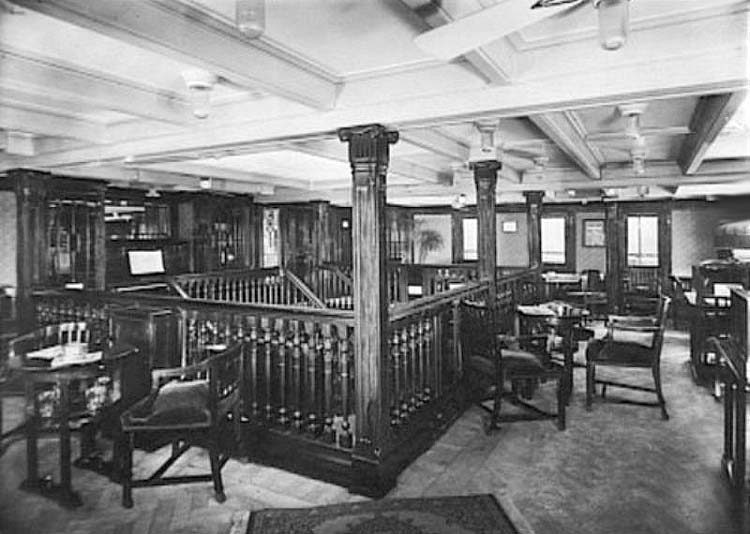
The Music Room
Directly aft was the Smoking Room and it was somewhat reminiscent to the First Class venue of the same name, as it also had a balustrade looking down into their Dining Room below. It was a beautifully timbered room and superbly furnished, it was a most popular venue.
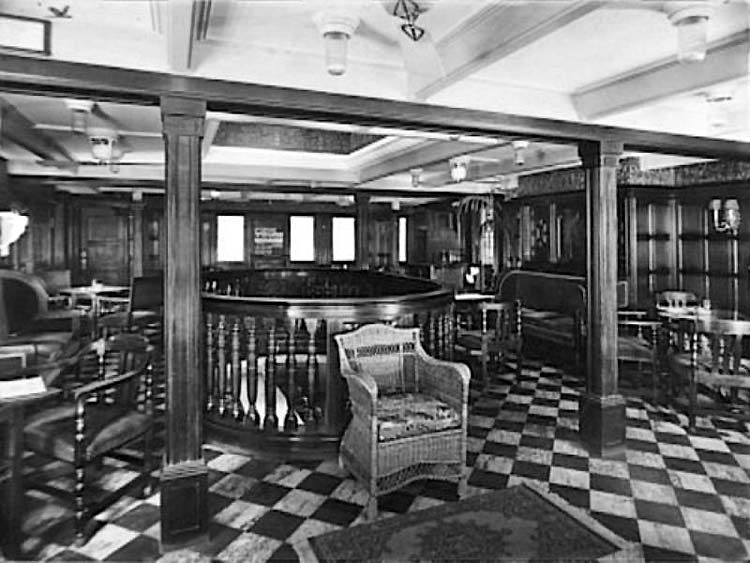
Here we see the Smoking Room with its service Bar
The spacious Dining Room featured two rows of long tables in the centre, and various sides smaller tabled to the sides. The venue had parquet floors and a variety of artistic features, making it an impressive room.
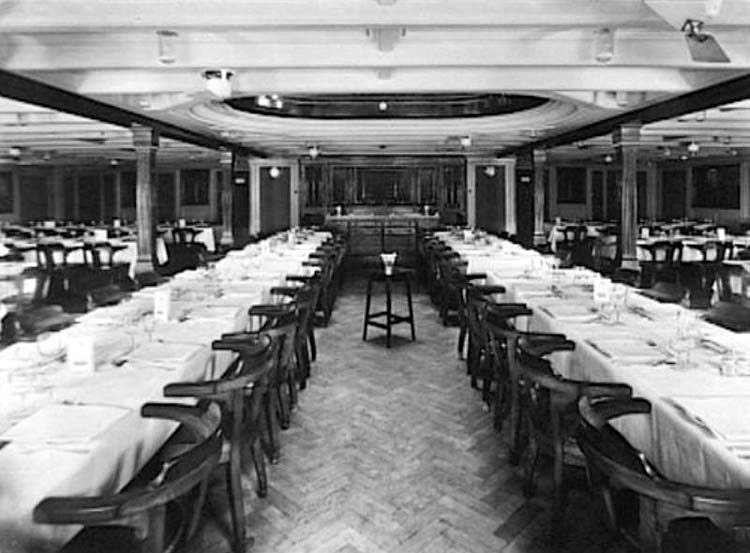
The Dining Room
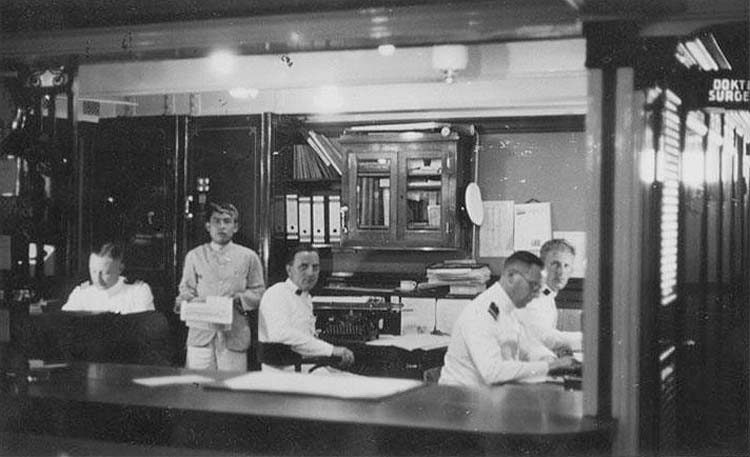
The Pursers Office
Johan-de-Witt-pax-prom
Passengers out on Promenade Deck aft
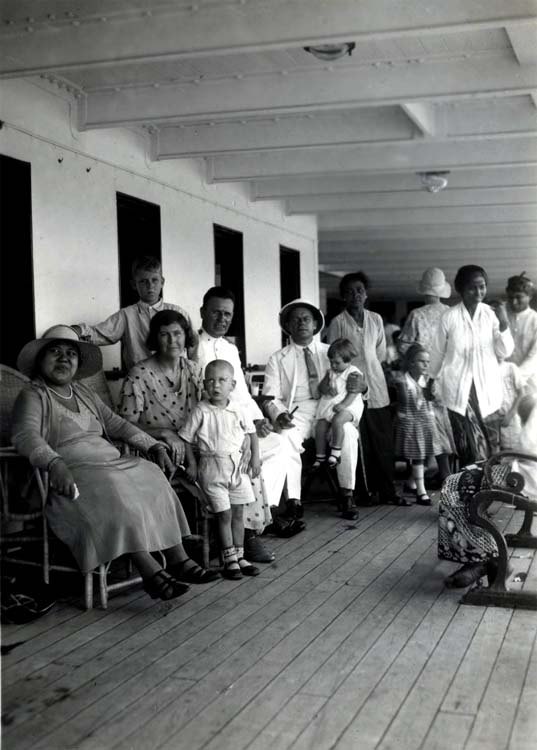
Johan-de-Witt-S-Childrens-Deck-Party
Children’s Deck party
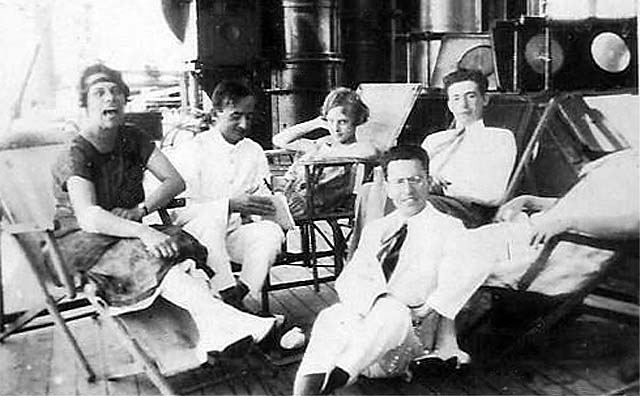
Passengers having fun out on deck
Once again, just like in First Class, Second Class cabins also were all outside cabins having a porthole for light and fresh air.
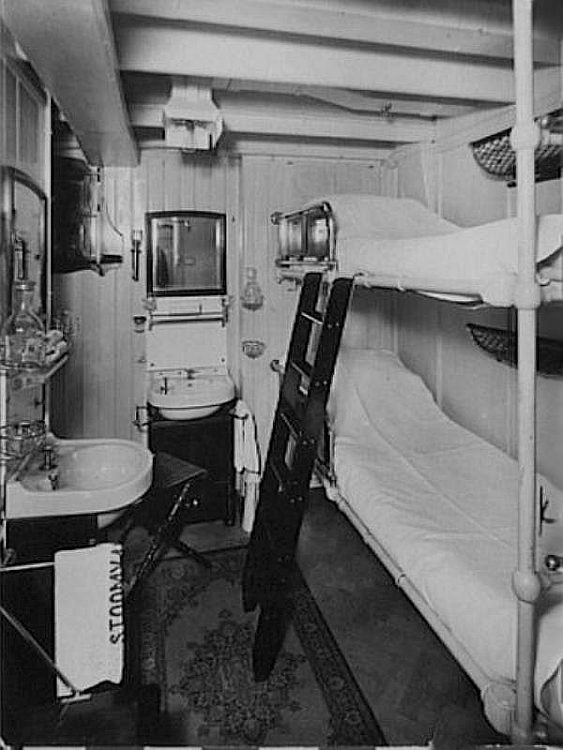
Two berth cabin
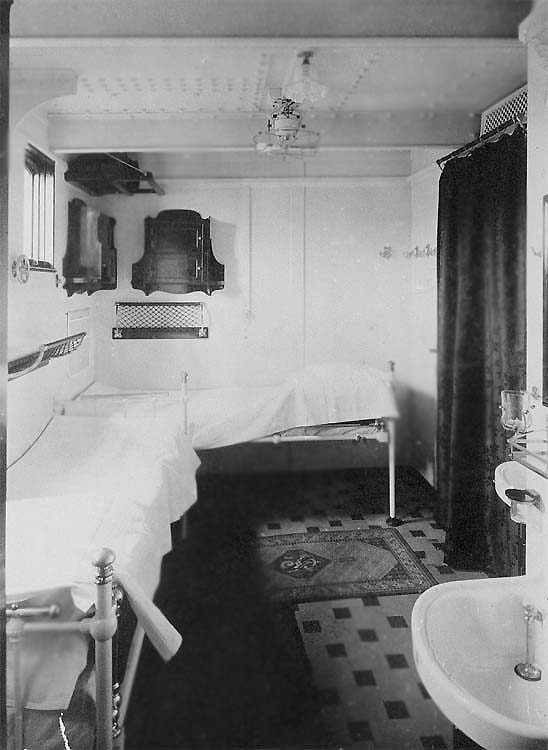
Two bedded cabin
*********************
Third Class:
There is no doubt that Third Class was not
very luxurious, for it was not, however it offered value for money ocean travel
and passengers were well cared for and very well fed and accommodated. Sadly I
have not been able to obtain many photographs, but below is what I have been
sent by
In addition to Third Class there was also what was known as ‘Steerage Class’, that had just 42 passengers and they were generally immigrants, and would be berthed in male and female eight berth cabins, whilst some families would be berthed in a four berth cabin. They would use the same Smoking Room and Dining Room as the Third Class passengers which also only had 36 passengers (46 from 1933).
The only difference would be is that Steerage passengers would dine at a different time in the Dining Room.
Far aft on Promenade Deck (C) was a pleasant fully timbered Smoking Room being very traditional in every way and it was the place for entertainment and there was a service Bar of course, whilst outside there was a spacious fully covered Promenade Deck.
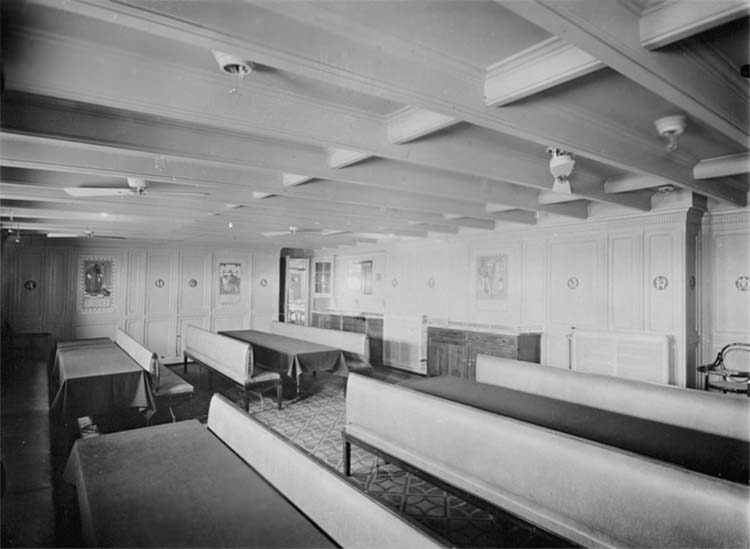
The Dining Room above was indeed relatively simple but certainly not unpleasant especially when it was set for meals; it had both long benches and tables, passengers would also use this venue when free for leisure, reading and playing cards, etc.
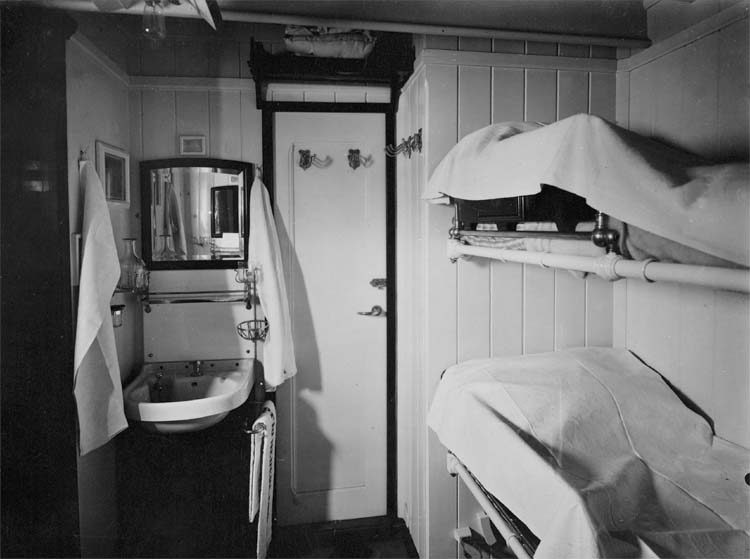
A typical outside 2 berth cabin
There were only two Third Class cabins that were inside rooms, thus without a window but they did have additional ventilation.
Steerage:
The Steerage Accommodations are located forward on F Deck where there are large cabins of various sizes, as well as their bathrooms and just aft of same a very large covered planked deck space. They also have access to part of the open deck up on D Deck, as well as the facilities of Third Class aft of the ship.
*********************
Her Maiden Voyage:
The “Netherland Line” commenced to
make her ready for service, as the ship was fully crewed, and she was stocked
her up with all the needs to make her a perfect Passenger Liner. Just prior to
her departure, her stores were filled with food and everything required for a
long and a happy voyage.
In 1924 she was given a minor overhaul with slight alterations being made to her accommodations, after which she then accommodated; 194 First Class, 123 Second Class, 36 Third Class & 42 Steerage passengers.
It soon became clear that her passenger loved this smart liner for she had everything that required to make such a long voyage very pleasant and a happy one!
In 1928 her schedule was as follows:
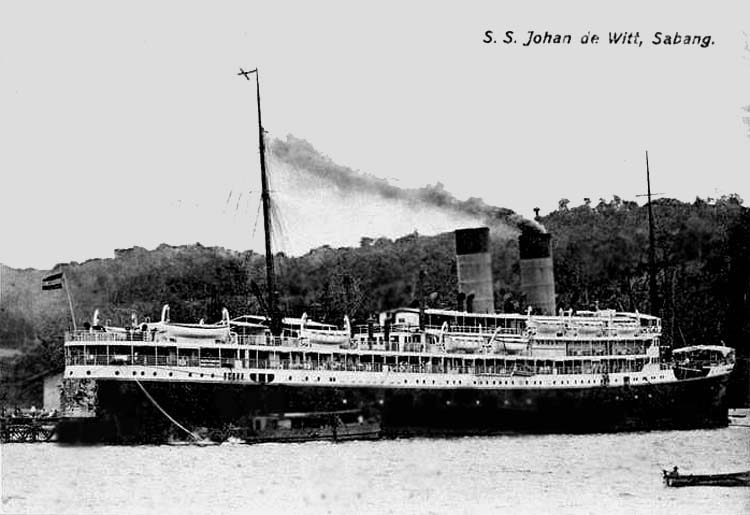
The “Johan de Witt” remained on the Amsterdam to the Dutch East Indies service until 1932, when she, together with the S.S. Jan Pieterszoon Coen were laid up on July 22, 1932 due to the new and prevailing crisis in Europe.
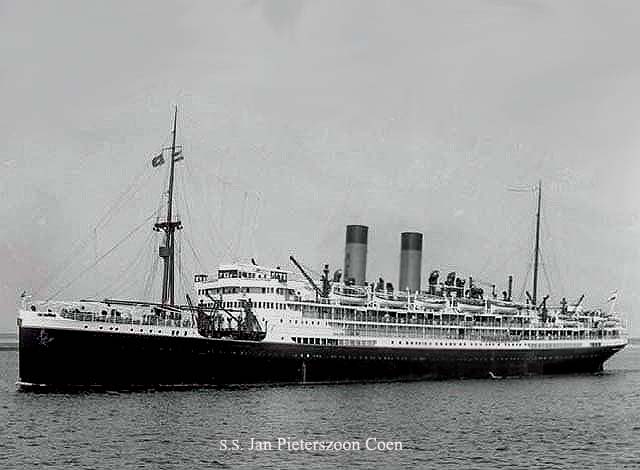
However due to one of the companies main
ships, the
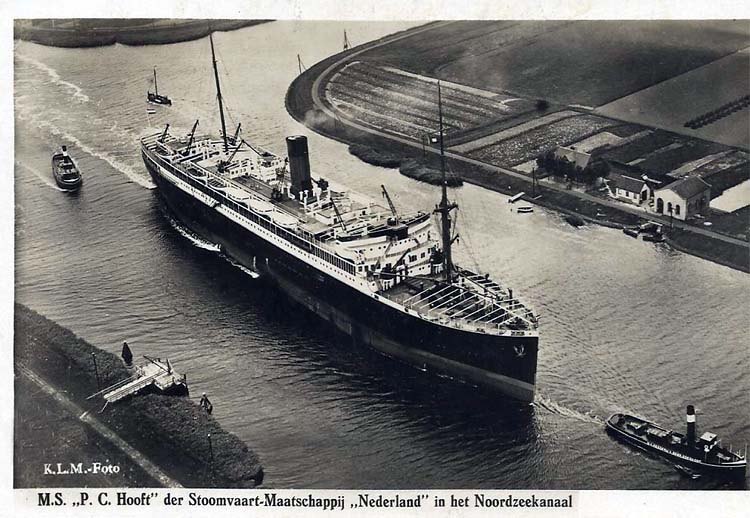
The “
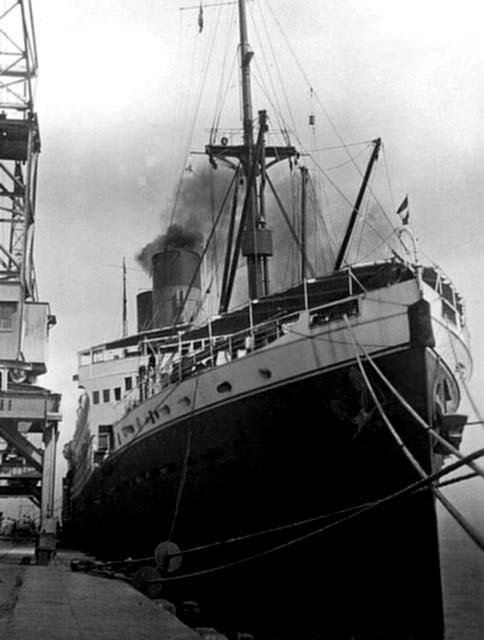
The three photographs above & below show her with the bow as built, then her bow removed, and finally we see the new ‘Maier-form’ bow.
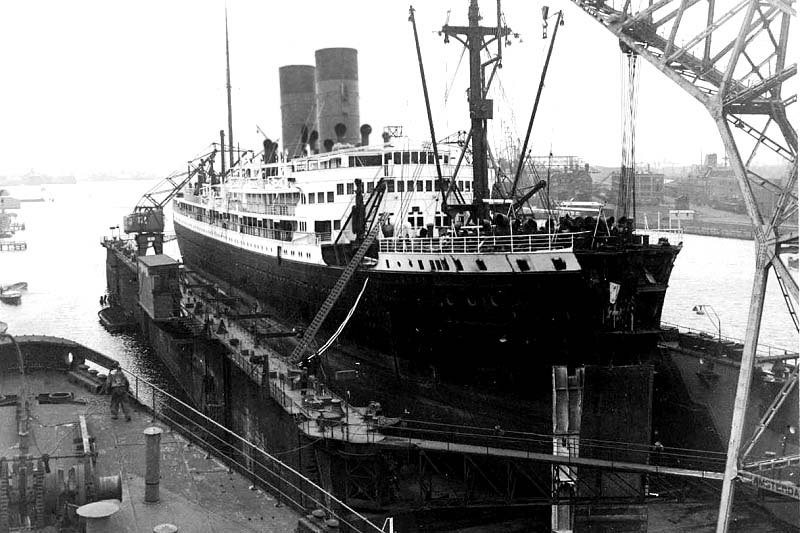
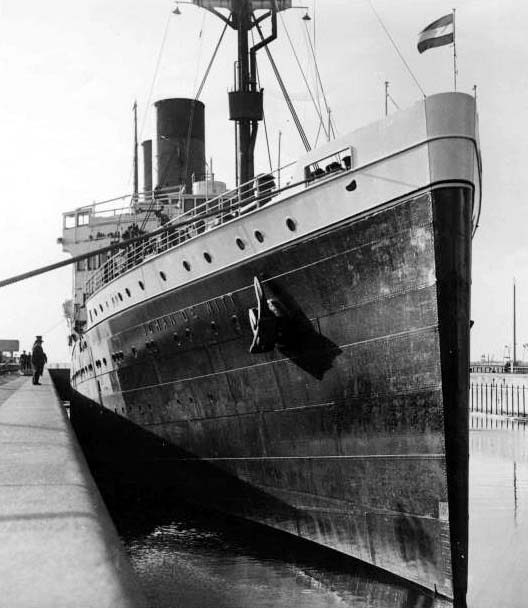
Considerable changes where made to her boilers but she was converted to being oil fired, rather then coal fired. Coal fired ships require a much larger crew and they are therefore far more expensive to operate a ship. In addition her engines where fully overhauled and all the work done saw her speed increase to an excellent 17 knots. When completed she undertook her new sea trials over two days, being on October 3 and 4, 1933.
However on the first day of her trials on the
October 3, it turned out to be an auspicious occasion out on the water, for the
very first ever Dutch ‘motor’ Seagoing Tug, the brand new “Zwarte Zee” (
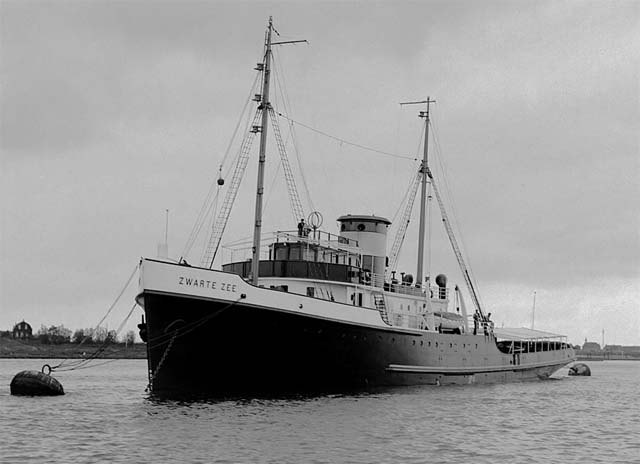
Above: The “Zwarte Zee” of 1933 was the third “L. Smit & Co International Towing Company” Tug to carry this name. What made this Tug special was the fact that she was the very first Ocean going Tug to be powered by diesel engines.
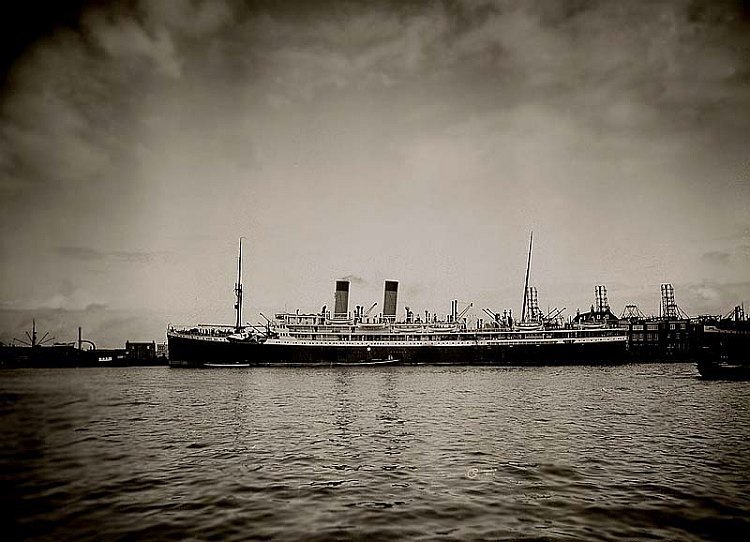
With her successful sea trial the “
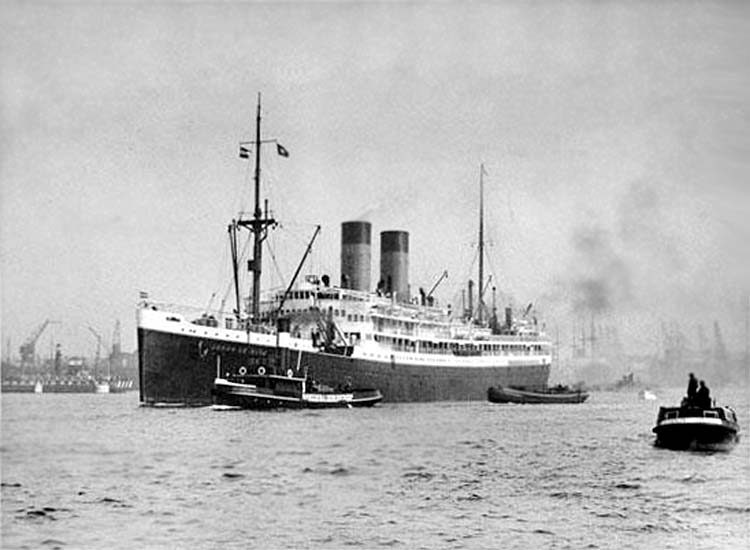
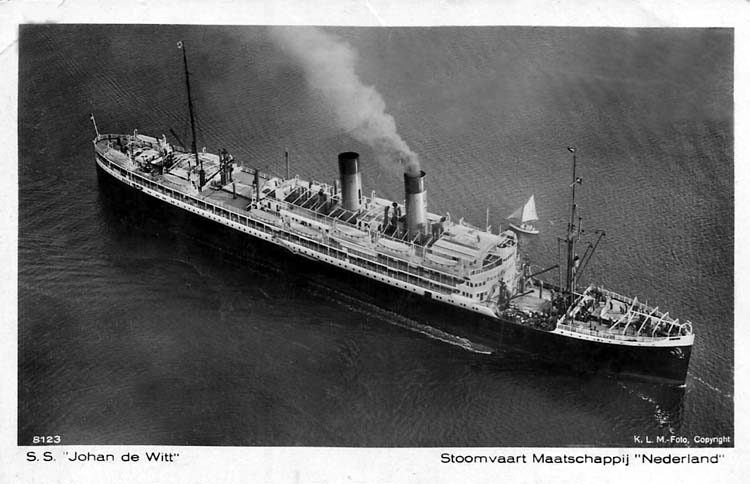
On October 25, 1933 the
However in due course, as the Netherlands was a neutral country they ensured that her hull was clearly marked with large white letters “JOHAN DE WITT - HOLLAND” on her starboard side and “AMSTERDAM” on her portside so that any German ship could see their neutrality, but it turned out that scumbag Hitler did not care less and attacked the Netherlands and invaded them anyway in 1940!
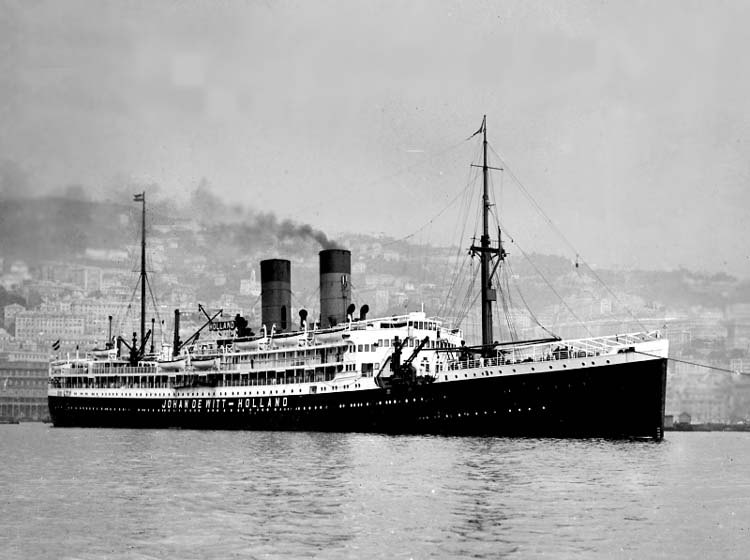
Here we see her clearly
marked as a ship from a neutral country
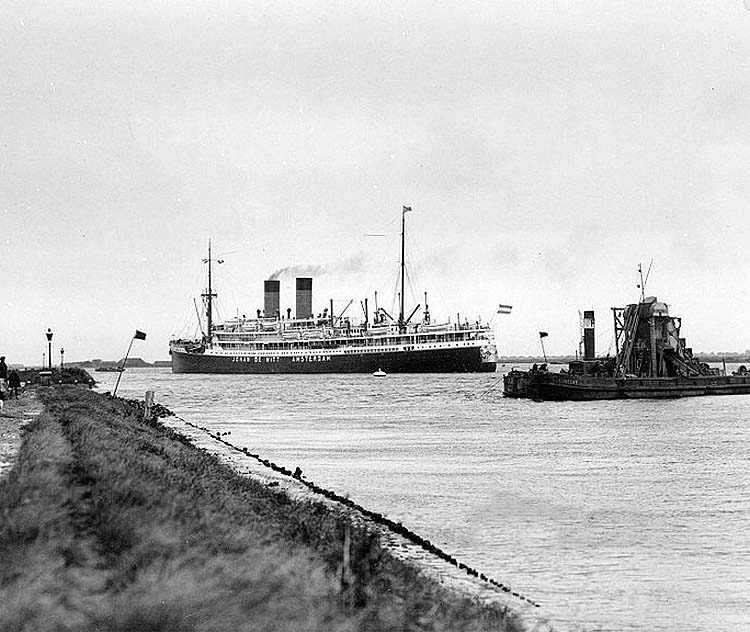
*********************
The Great War:
Whilst at
On her way to
Whilst in
On September 30, 1940 H.M.T.
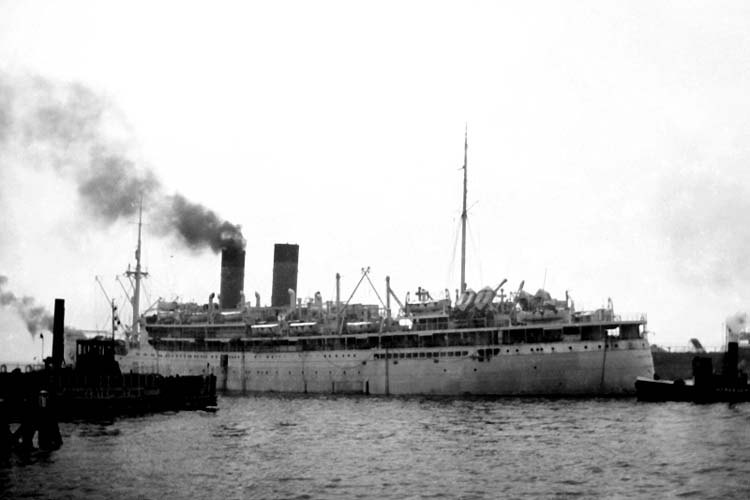
H.M.T.
Convoy
On October 21 the convoy departed Colombo and
headed for Aden, being escorted by the light cruiser H.M.S. Caledon,
arriving off Aden on October 28 where a number of merchant vessels joined the
convoy together with escort vessels; H.M.S. Shropshire. H.M.S.
Carlisle, H.M.S. Kandahar and the H.M.S. Flamingo.
The convoy arrived at
On January 16, 1941 Convoy US008/1
departed
Convoy WS 33
consisted of the following ships; Boissevain,
Indrapoera,
They departed Gibraltar on August 23, 1943 and
with convoy LGW 2 the, Indrapoera,
September 18, 1943, and as Convoy LGW 2
they departed again on September 21 and arrived Takoradi (
During the War
*********************
Post War:
On November 3, 1945 “
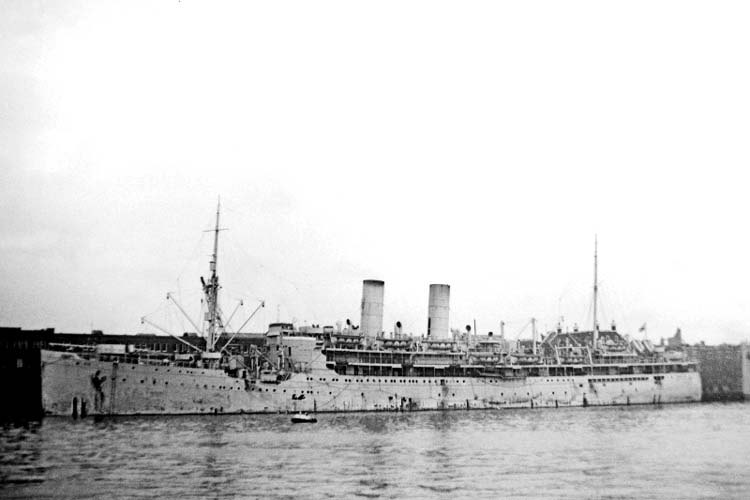
“
But it was on February 11, 1946, that she was officially transferred back to S.M.N. They decided to repaint her hull grey rather that the black hull of the past.
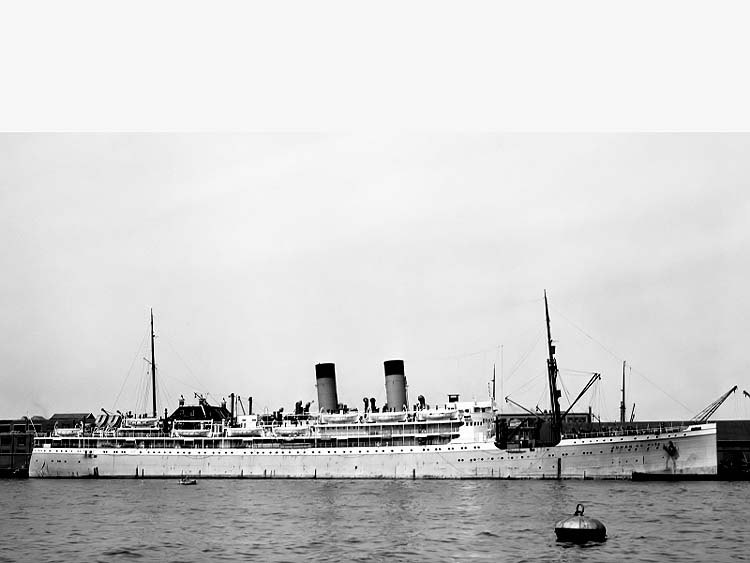
Here we see her having just received a refit and her new grey hull in February 1946
She received three charters contracts, the
first being from
Then the “
Below is part of an article from “The
Cairns Post” on Monday March 17, 1947 re the arrival of the “
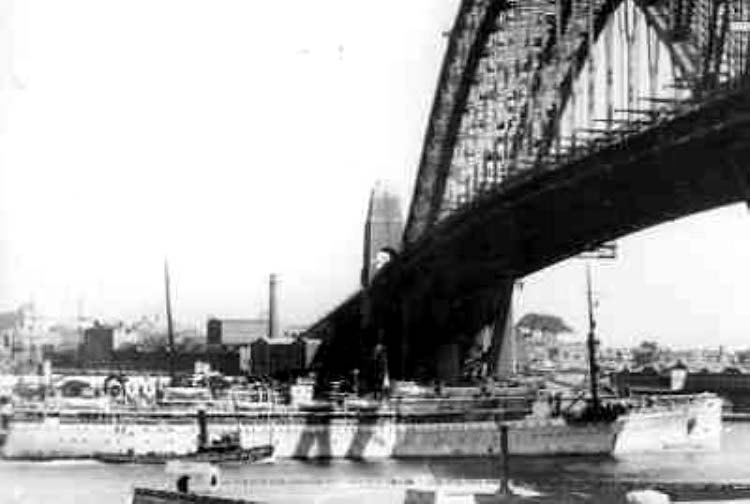
A poor, but a very
rare photo of the “
Thank you
JEWISH
REFUGEES ARRIVE AT
“Seven hundred Jewish refugees who
arrived on the Dutch steamer
A Dutch ex-serviceman, who arrived from
He said that shipping lines in
The chairman of the Migrants Reception
Committee greeted the refugees on the wharf. He said that the refugees were
being accommodated in the homes of friends and relatives in
After
With the “
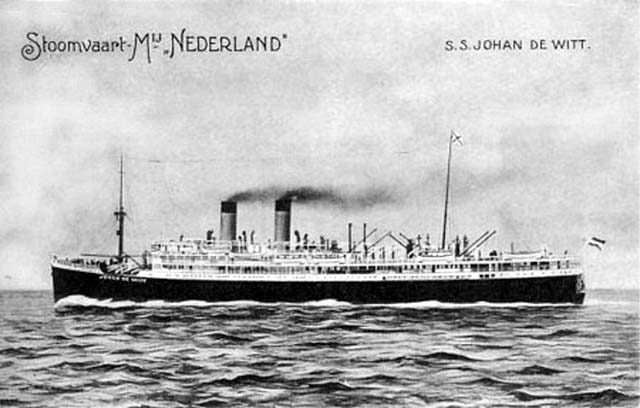
A
delightful postcard of the “
*********************
Names:
. Neptunia 1948 - 1958.
Classification Register:
Category: Passenger-Cargo Liner.
Owner 1: “NV
. “Netherlands Steamship Company”.
Owner 2: “
Owner 3: “Neptunia Shipping Co. SA” the “Greek
Line”
Manager 1: “NV
Manager 2: “Goulindras Brothers Ltd”,
Manager 3: “Goulandris
Brothers Ltd”,
Homeport 1:
Homeport 2 & 3:
Flag:
.
Call signs: PFRH, PFDM in 1934.
Built by: “NV
. “Dutch
Shipbuilding Company”,
Laid Down: July 29, 1916.
In Yard No: 150.
Type: Passenger/cargo vessel.
Type Deck: Shelter deck closed.
Masts: Two
masts.
Keel laid down: July 29, 1916.
Launched: May 2, 1919.
Sea trial: July 27, 1920.
Delivered: July 27, 1920.
Maiden voyage: August 21, 1920.
Tonnage: 10,519 GRT - 1920.
. 10,354 GRT - 1928.
. 10,474 GRT - 1933.
Length: 146.92 m - 482.283 ft as built.
. 153.12 m - 506.2 ft in 1933.
Beam: 17.98 m - 59.2 ft.
Draught 9.14 ft - 11.60 m.
Engines: Two x 3-cyl, Triple expansion engine, 1,171 N.H.P.
Propellers: Twin screws.
Speed: 15.5 knots - 17 knots in 1933.
Passengers: 188 First Class, 120 Second Class, 36 Third Class, & 42 Steerage.
1924: 194 First Class, 123 Second Class, 36 Third Class, & 42 Steerage.
1933: 105 First Class, 151 Second Class, 46 Third Class, 42 Steerage.
1937: 103 First Class, 151 Second Class, 46 Third Class, 42 Steerage.
1945: 1,140 passengers in One Class.
Crew: 225 in 1920 to 1940.
Other Details:
Laid up: December 1930.
Back in Service: November 1932.
1932/33: Refitted
at the “
1940: Refitted
as a troopship in
1945: Returned to her owners.
Fate: Sold to Ship breaker “NV Levie Simons”, on March 7, 1958 she arrived at the Dutch yard to be broken up.
*********************
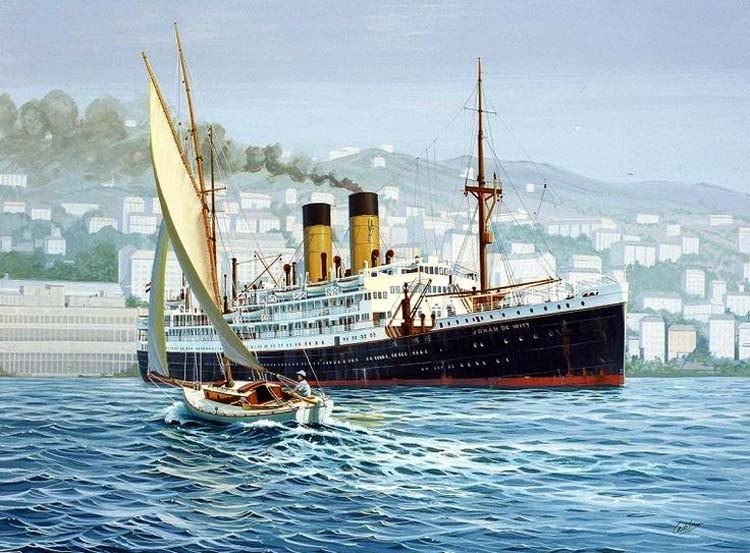
The
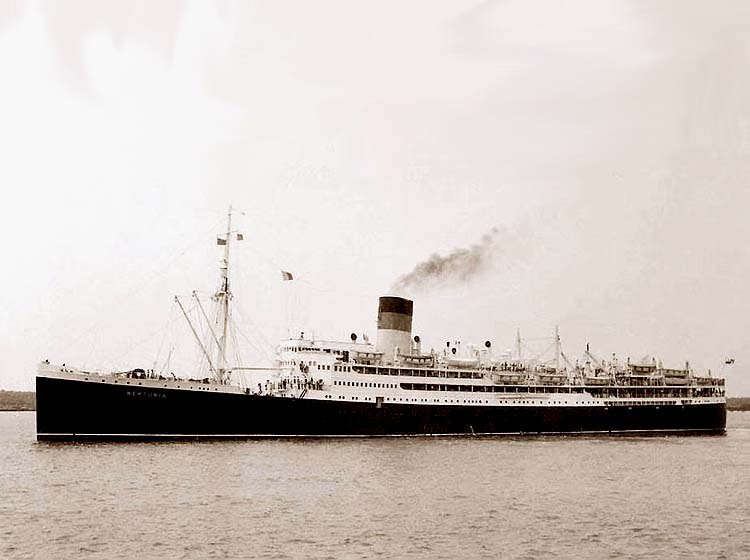
and only between 1954 to 1958 did she feature the Greek Line’s “Yellow Trident” on her funnel
Enter Page Two - the T.S.S. Neptunia page
**************
I watched them come, I watched
them go and I watched them die.”
Featuring over 1,435 Classic Passenger Liners, Passenger-Cargo Liners & Classic Cruise Ships!
Or ENTER HERE
For interest: Sadly an email service to ssMaritime is no
longer available, due to the author’s old age and chronic illness as well
as being disabled, etc. In the past ssMaritime received well over 120 emails
per day, but
*********************
ssMaritime.com & ssMaritime.net
Where the ships of the past make
history & the 1914 built M.S. Doulos Story.
The Author has been in Passenger Shipping & the Cruise Industry for well over 60 years
In addition he was the founder of “Save the Classic Liners Campaign” in 1990.
Please Note: ssmaritime and associated sites are 100% non-commercial and the
author seeks no funding or favours of any
shape or form, never have and never will!
Photographs on ssmaritime and associate pages are by; the author or from the author’s private collection. In
addition there are some images that have been provided by Shipping Companies
and private photographers or collectors. Credit is given to all contributors.
However, there are some photographs provided to me without details regarding
the photographer/owner concerned.
This notice covers all pages; although, and I have done my best to ensure that all photographs
are duly credited and that this notice is displaced on each page, that is, when
a page is updated!
ssMaritime is owned
& © Copyright by

